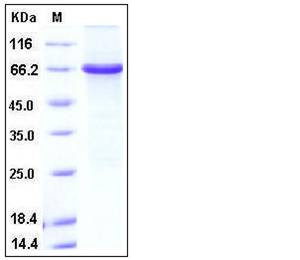Human ANGPTL5 Protein (GST Tag)
ANGPTL5
- 100ug (NPP1065) Please inquiry
| Catalog Number | P11094-H09B |
|---|---|
| Organism Species | Human |
| Host | Baculovirus-Insect Cells |
| Synonyms | ANGPTL5 |
| Molecular Weight | The recombinant human ANGPTL5/GST chimera consists of 588 amino acids and predicts a molecular mass of 68 kDa as estimated in SDS-PAGE under reducing conditions. |
| predicted N | Met |
| SDS-PAGE |  |
| Purity | > 90 % as determined by SDS-PAGE |
| Protein Construction | A DNA sequence encoding the mature form of human ANGPTL5 (NP_835228.2) (Asn 26-Lys 388) was fused with the GST tag at the N-terminus. |
| Bio-activity | |
| Research Area | Signaling |Signal Transduction |Metabolism |Types of disease |Metabolism in Cancer |
| Formulation | Lyophilized from sterile 50mM Tris, 100mM NaCl, pH 8, 0.5mM GSH, 0.5mM PMSF, 0.5mM EDTA 1. Normally 5 % - 8 % trehalose, mannitol and 0.01% Tween80 are added as protectants before lyophilization. Specific concentrations are included in the hardcopy of COA. |
| Background | The angiopoietins are protein growth factors that promote angiogenesis, the formation of blood vessels from pre-existing blood vessels. There are now four identified angiopoietins: Ang1, Ang2, Ang3, Ang4. In addition, there are a number of proteins that are closely related to angiopoietins (ANGPTL2, ANGPTL3, ANGPTL4, ANGPTL5, ANGPTL6, ANGPTL7). Angiopoietin-like 5 (ANGPTL5) is mainly expressed in adult heart. Like other members of the angiopoietin family, ANGPTL5-deduced protein also has an N-terminal cleavable signal peptide, a predicted coiled-coil domain, and a fibrinogen-like domain. ANGPTL5 are regulators of lipoprotein metabolism in humans. ANGPTL5 plays nonredundant roles in TG metabolism, and multiple alleles at these loci cumulatively contribute to variability in plasma TG levels in humans. |
| Reference |
